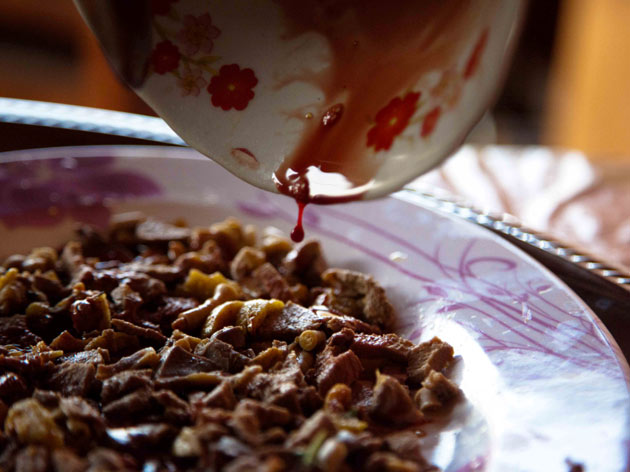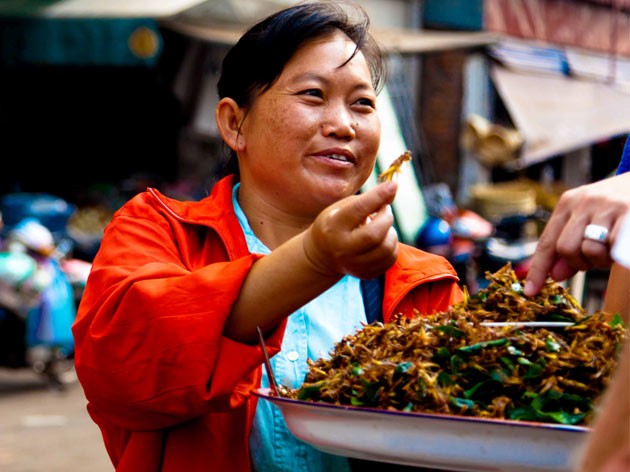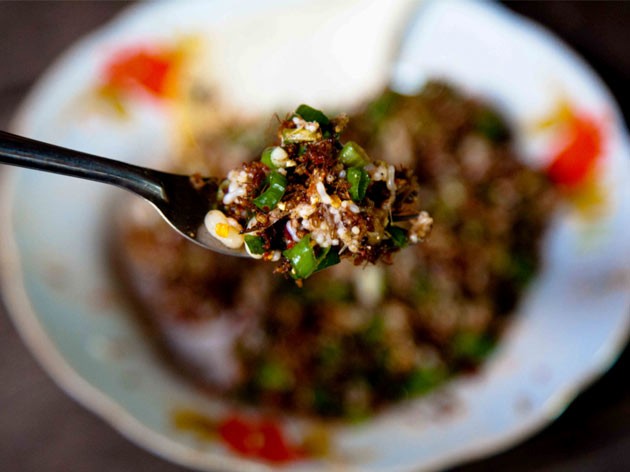 Nicole Frisina writes: Bite. Chew. Swallow. It is easier said than done. Particularly when faced with a deep fried tarantula the size of your hand or an embryonic egg, sevens weeks in the making. Travelling through Asia can challenge many of your attributes but none more acutely than your tastebuds and, perhaps, gag reflex. If you’re game, start chewing through this list and see where you end up.
Nicole Frisina writes: Bite. Chew. Swallow. It is easier said than done. Particularly when faced with a deep fried tarantula the size of your hand or an embryonic egg, sevens weeks in the making. Travelling through Asia can challenge many of your attributes but none more acutely than your tastebuds and, perhaps, gag reflex. If you’re game, start chewing through this list and see where you end up.

Phed Lued: Duck’s Blood Salad*

Picture a large plate pooled with warm, velvety duck’s blood and diced duck’s entrails … yum! This recipe is a Lao delicacy, usually saved for New Year’s celebrations. However, the village I was in at the time (I worked for WWF, the conservation outfit not the wrestling) had slaughtered a duck in honour of my team’s arrival. There was only one respectful way forward — I had to eat.
Balling a hunk of sticky rice in one fist, I smiled broadly (petrified) and scooped up as little of the offering as possible. Bite. Chew. Swallow. Iron and fire is the enduring memory of this experience — the metallic mouthful of duck’s blood and the breathtaking fire of the rice wine shot that swiftly followed. I think I managed two goes at it before declaring I was completely full and verging on drunk.
Despite it all, I had the dish again but this time in Vientiane, the capital city. The duck had been barbequed and then finished with lashings of fresh blood. And, it wasn’t too bad at all. If you’re game and find yourself in Vientiane, Laos, try one of the barbeque duck shops opposite Settha Palace for a fix of phed lued.
*‘Salad’ is a little misleading. A lettuce leaf, or foliage of any kind, has never been near this dish. When you see ‘salad’ on a menu generally read ‘meat’.
The “blue cheese” of Indochina

In Vietnam they call it “mum“. In Cambodia it’s “pra’hock“, and in Laos, “padhek“. In all countries it is a matter of national pride and an essential ingredient for any self-respecting fishing village or marketplace. So what is it?
Take a good couple of kilos of freshwater fish, usually catfish or tilapia, and gut it. Put the fish into a plastic drum and mix it with around a kilo of salt (for the Lao version use pink rock salt from Savanakhet). Seal the drum and in six months time come back, add a little water, replace the lid and leave it for another six months.
When the year is up what remains is a wet, grey, lumpy soup of fermented fish. Open the lid at your own risk. The smell of a fully matured vat of this stuff imprints your olfactory system like a shadow following a nuclear explosion.
Rumoured to be the most protein-rich dish known to mankind, people across the Mekong region eat this so called “blue cheese” with sticky rice, or use it as an essential flavouring for other dishes. Its taste, while pungent, is nowhere near as bad as its bouquet. In fact, when pounded in a mortar and pestle with herbs, chilli and a little rice powder it is more than edible, it is actually quite tasty.
“Incy wincy” and other crunchy critters

On the road between Siem Reap and Phnom Penh, Cambodia, there is a bus stop unlike any other for eight black and hairy reasons — tarantulas, alive and deep-fried.
Kampong Cham is the name of the town where the bus stop resides. Children (who probably should be in school) will accost you as you step from your vehicle proffering handfuls of live tarantulas. The spiders have had their fangs pulled out so they are harmless, but because of this they only live a couple of days.
Surprisingly, the tarantulas are docile. I’m told this is because the sensory hairs on their legs (which are a little prickly) over stimulate if they move around too much. While I was there, I watched a local woman dubbed ‘the spider whisperer’ sing one from its hole in the ground, and then handle it like it was a toy mouse.
If the live variety of tarantula is a bit much for you, then try the snack version. Marinated in oyster sauce, deep-fried and sprinkled with salt and MSG they are a bargain at a dollar a bag. To be fair, I can’t claim to have actually bitten down on one. But, I am told by reliable sources, that their bulbous bodies have the consistency of peanut butter and their hairy legs have an oily crunch.
Insects are the other classic snack, which pack a decent crunch. If you can get over their tiny faces and googly eyes frozen in time by the flash fry, crickets, grasshoppers and bugs in general are truly delicious beer snacks. They are also high in protein and they don’t take up acres of space, making them a rather sustainable snack.
Goy Mot Khai Deng: Red Ant Salad

This is dish comes with a warning: it bites back. Red ants are found across the Mekong region and they have a notoriously nasty bite. For locals in southern Laos, turning them into a salad might be a little sweet revenge.
To catch the ants, balls of sticky rice are stuck to tree branches as bait. When the ants swarm, rattan baskets on long poles are used to scoop and rattle the ants from the tree. Once in the kitchen, the ants (and ant eggs, if you’re lucky) are doused with lime juice, which effectively begins to cook them like ceviche. Spring onion, mint and chilli is diced and added to the ants along with a few potent spoonfuls of ‘padhek’ (noted above). Finally, the seasoned ants are combined with cooked rice, ready to eat.
And the eating? It is painful. In a final strike, before they hit your digestive juices, the ants that you missed crushing with your teeth, bite their way down the length of your throat. But I suppose, all is fair in love and war.
Puk Bong: Morning glory of a different kind

‘Morning glory’, not of the appendage kind but of the Mekong River weed variety, rates a mention because it is my favourite dish. Available in all Mekong countries, it is thinner and stringier than bok choy and comes stir-fried with garlic and chilli. If none of the above tickles your fancy then order this dish and I promise, you will not be disappointed. After all, how can something that goes by the name, ‘morning glory’, ever be wrong?
Nicole Frisina is a self-confessed globetrotter and food lover. A Melbourne-based television producer by day and a freelance writer by night, she is currently working on the next series of Luke Nguyen’s Greater Mekong on SBS. Follow her on Twitter @Nicfrisina







Crikey is committed to hosting lively discussions. Help us keep the conversation useful, interesting and welcoming. We aim to publish comments quickly in the interest of promoting robust conversation, but we’re a small team and we deploy filters to protect against legal risk. Occasionally your comment may be held up while we review, but we’re working as fast as we can to keep the conversation rolling.
The Crikey comment section is members-only content. Please subscribe to leave a comment.
The Crikey comment section is members-only content. Please login to leave a comment.